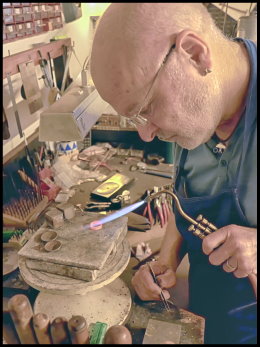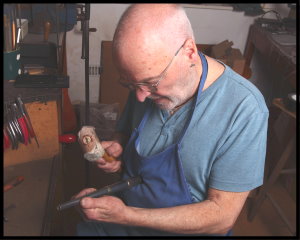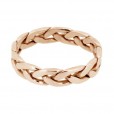About Kelvin Jenkins

Kelvin at work in his workshop
Kelvin Jenkins first became a jeweller over 50 years ago when he began studying at the Camden Institute in London in 1968, under the guidance of the late Rod Edwards, master jeweller and text-book author. Before that Kelvin had been an archaeologist, working on sites in the Outer Hebrides, Czechoslovakia, and Pennsylvania. Archaeology included the study of ancient jewellery and also the techniques of metal working, and Kelvin began to feel a desire to make rather than merely study. And it was the visit to America, and to small craft workshops there that first inspired him to change careers.
The late 1960’s and early 1970’s was an exciting period in the history of British jewellery. By 1972 Kelvin had exhibited and sold work in several prestigious galleries, including the Arnolfini in Bristol; the Gardner Arts Centre, Brighton; Pace Gallery, Booty, Electrum and Amalgam galleries in London. He set up a workshop in London, moved it to Dorset and then to Northumberland, before he and his wife Judy decided in 1984 to move business and family to Machynlleth, in Powys, Wales, which is Kelvin’s home town. They bought the present shop in 1988. Since then jewellery made in the Machynlleth studio has gone all over the world.
Kelvin has been working in Welsh Gold since 1985, when he first persuaded the owners of the Gwynfynydd gold mine to supply him with this highly-prized metal, and was also granted the necessary consent from the Crown Agents. Welsh Gold is considered to be the most rare and valuable of all metals. It was the fulfilment of an old ambition when Kelvin finally succeeded in securing a small supply of it.

Kelvin in his workshop
In addition to Welsh gold he works in conventional gold of all colours and carats, as well as silver, platinum and palladium. White precious metals are very much in fashion at present, and besides white gold Kelvin is making more and more items in platinum or palladium. These metals are difficult to work but are hard and long-lasting and give beautiful results. His love of experiment has also led over the years to work in plastics, enamels, Welsh slate and other materials. Inspiration still comes from archaeology and ancient Celtic design as also from the natural forms in the lovely Welsh countryside all around, and from other artistic traditions, including Japanese. Basic geometric forms are a major source of ideas.
Gemstones are another love, and Kelvin has studied gemmology and equipped his own gemmology workshop for identifying and examining stones. He is very fussy about the quality of gems he uses, whether coloured ones like sapphires and rubies, or the ever-popular diamonds. All diamonds used in his work are of much better colour and clarity than the usual commercial grade. In addition all diamonds are guaranteed conflict-free, meaning that money from their sale is not financing wars. Customers receive expert technical advice and information on gemstones and all matters concerning jewellery-making from hall-marking to design.
Welsh Gold is probably the thing that has made Kelvin best-known. The problem is that Welsh Gold has become rarer and rarer since Kelvin began working with it in 1985. At present there is no mine being worked commercially in the Dolgellau goldbelt area, and although some gold is still found in the rivers, it is in very small amounts. If Kelvin had continued to make jewellery only in unmixed Welsh Gold his remaining reserve would soon have been exhausted, so he made the difficult decision to produce a range of jewellery containing Welsh gold mixed with gold from other areas. This also made them much more affordable and has proved very popular over the ensuing years.
The standard range as priced on these pages contains a stated amount of precious Welsh Gold – a generous 5% (unlike some other jewellery which is described as containing “a touch of Welsh gold” without giving any precise figure). Higher percentages of Welsh gold are also available and can be quoted for. The design range is still small at present as each individual piece is laboriously hand made from solid metal, rather than being cast in batches in moulds from molten metal. Despite the immense amount of hand-work involved in manufacture of this range, from alloying to forming, the prices are surprisingly modest.
After being sent to the Edinburgh Assay Office for testing and hallmarking each piece is clearly marked with special Welsh Gold punch marks and comes with an attractive numbered certificate of authenticity. Kelvin has two makers marks as part of his Edinburgh Assay Office hallmark – an oval “KJ” is reserved for Welsh gold items and a longer “PKJ” for non-Welsh gold items and other precious metals. Two other marks guarantee the Welsh gold content and specify the percentage of Welsh gold. Incidentally Kelvin is proud of being probably the longest-registered jeweller using the Edinburgh Assay Office.

 9ct Welsh Gold, Rose Gold Medium Plait Ring
9ct Welsh Gold, Rose Gold Medium Plait Ring  9ct Welsh Gold, White Gold 2.5mm D Section Wedding Ring
9ct Welsh Gold, White Gold 2.5mm D Section Wedding Ring  9ct Welsh Rose Gold 6mm Cushion Fit Wedding Ring
9ct Welsh Rose Gold 6mm Cushion Fit Wedding Ring  9ct Welsh Rose Gold 4mm Cushion Fit Wedding Ring
9ct Welsh Rose Gold 4mm Cushion Fit Wedding Ring  18ct Welsh Gold 7mm Flat Band Wedding Ring
18ct Welsh Gold 7mm Flat Band Wedding Ring